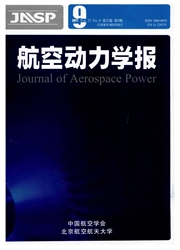

 中文摘要:
中文摘要:
建立了基于整个燃烧室内经历不同燃烧方式下所有工质来评估脉冲爆发动机平均循环热效率的方法,通过二维数值方法对两种采用不同数目障碍物的爆震管模型的起爆特性及循环热效率进行了研究,并分析了燃烧波传播的距离与DDT距离之比(定义为ξ)对模型热效率的影响.结果表明:1间接起爆方式及不同DDT强化装置都会影响系统的循环热效率;2就计算模型,当ξ接近1时,其系统平均循环热效率仅为理想爆震循环热效率的60%左右;3随着ξ的增加,间接起爆方式的影响迅速减弱;4当ξ为1.5时,系统平均循环热效率可达爆震燃烧热效率的93%.
 英文摘要:
英文摘要:
To analyze the influence of indirect initiation, a method was first established to evaluate the average cycle thermal efficiency of the system whose working fluid experienced different combustion processes in combustion chamber. Then, the thermal efficiency and deflagration to detonation transition (DDT) characteristics of two detonation tube models with different obstacles were investigated by the 2-D numerical simulations. The ratio of combustion wave run-up distance to DDT distance (defined as ξ) was also studied. The results show that: (1) the thermal efficiency of the pulsed detonation engine (PDE) model can be both influenced by the indirect initiation and different obstacles; (2) when ξ approaches to 1, the average thermal efficiency of the system is only 60% of ideal detonation cycle; (3) the effects of indirect initiation are weakened with the increase of ξ; (4) when ξ approaches to 1.5, the average thermal efficiency will reach 93% of ideal detonation cycle.
 同期刊论文项目
同期刊论文项目
 同项目期刊论文
同项目期刊论文
 期刊信息
期刊信息
